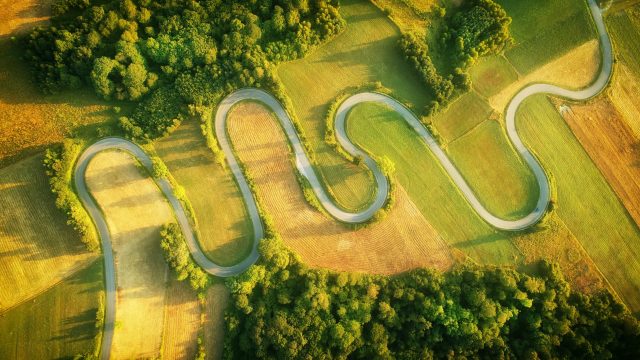Quick Links
Costa Brava | Costa Dorada | Costa del Azahar | Costa Blanca | Costa Cálida
Spain has miles of incredible sandy and rugged coasts, which translates to costas. These coastlines over the years have been split and named according to the attributes that they boast. Some are more well-known than others, usually in direct correlation to the number of tourists that visit year on year. There are 10 that make up the mainland coast of Spain; our guide below highlights key areas in those on the east coast to help you decide which, if not all, you want to plan into your itinerary during your next trip to Spain. Booking car hire in Spain is the best way to ensure that you can explore as much as you like, whenever you like, so get a quote today.
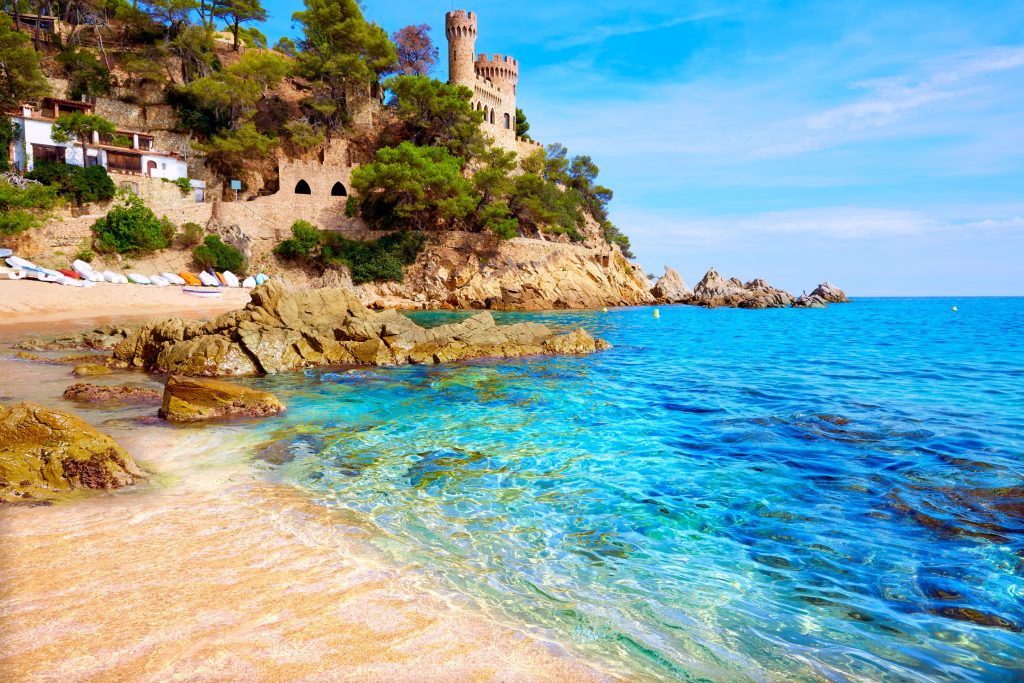 Sa Caleta beach in Lloret de Mar, Costa Brava. Photo by: lunamarina/Stock
Sa Caleta beach in Lloret de Mar, Costa Brava. Photo by: lunamarina/Stock
Costa Brava
The Costa Brava stretches along the north-eastern end of the Catalonia region in Spain, from Blanes (or specifically, the mouth of the River Tordera) up to the French border. It’s known as the Wild Coast or the Rough Coast due to its rugged cliff coastline and secluded hidden coves. There’s a great mix of wild countryside plus pebble and sand beaches. Many fishing villages in the Costa Brava retain their authenticity and haven’t yet been completely lost to tourism.
The Costa Brava has been heavily developed for tourism since the 1950s. Artists such as Salvador Dalí, Pablo Picasso, and Joan Miró are connected to the area. Art-lovers should visit the Dalí Theatre-Museum which is in his hometown of Figueres. His body is buried here in a crypt, below the stage. The building itself displays the largest collection of works created by Dalí and works by others that Dalí had collected.
The largest resort is Lloret de Mar, home to a Blue Flag beach. There is a coastal walk from the town’s seafront promenade to that in Fenals. It’s an attractive route that hugs the coastline encompassing coves for snorkelling, the sculpture Dona Marinera (Seafarer’s Wife), a pine grove, and the Castle of Sant Joan.
Girona Airport car hire allows you to easily access this region as it’s the closest. While in Girona, why not explore the Arab baths on offer or wander around the old quarter. Just outside Costa Brava is Barcelona so if you plan to collect your hire car at Barcelona Airport, you’ll also be conveniently located to explore the area.
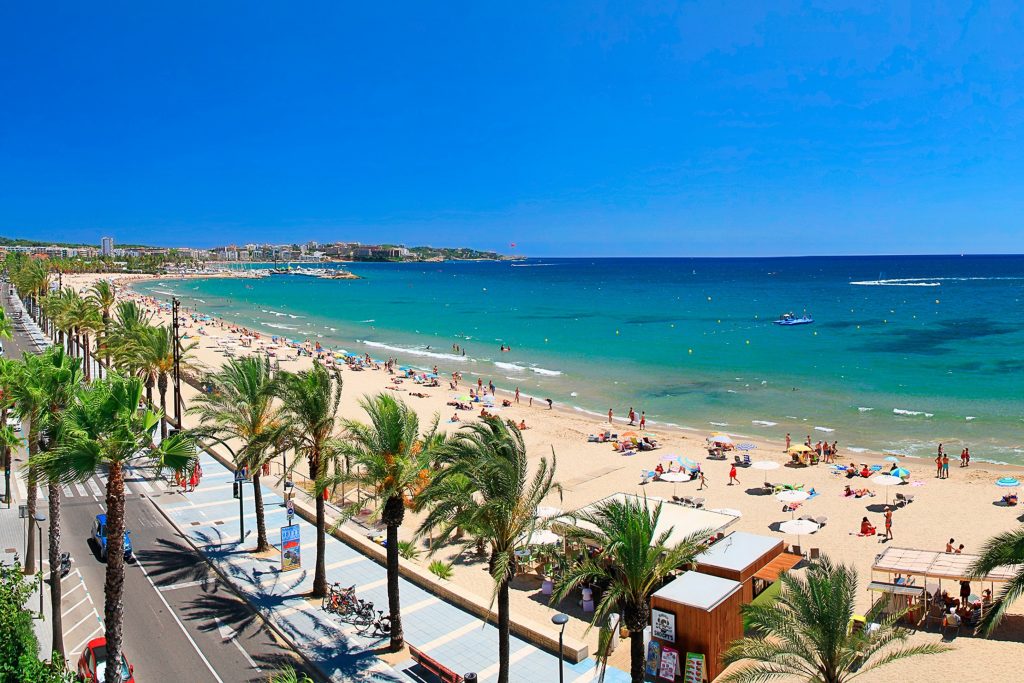 Salou beach in Costa Dorada. Photo by: ATLANTISMEDIA/Stock
Salou beach in Costa Dorada. Photo by: ATLANTISMEDIA/Stock
Costa Dorada
Below the Costa Brava, running from Castelldefels, south of Barcelona, to the city of Tarragona is the Costa Dorada, or Daurada. Translating as “Golden Coast”, you’ll soon discover the luxurious colour of the sandy beaches. There’s 140 miles of pristine, golden, Blue Flag-awarded beaches for you to enjoy and 17 individually, including 3 nudist beaches.
Collect your hire car from Barcelona Airport and make the trip south to explore and indulge in sea-side relaxation and water sports. Visit Salou where you’ll find the PortAventura World theme park. It also holds Rally Catalunya, part of the World Rally Championships, every year. Nearby Sitges is known by many for its Film Festival which specialises in fantasy and horror films. Its Carnival takes place February-March and includes around 40 floats that participate in the Debauchery Parade and the Extermination Parade.
Parc Natural del Garraf, or Garraf Park, near Sitges covers 12,820 hectares of limestone hills and includes some forested areas and caves. It’s a popular place to hike and cycle. Locate Plana Novella in the heart of the park, once a mansion, now converted to a Buddhist Temple. It was the first Buddhist monastery in Catalonia so is worth a visit to view the eclectic architecture and Tibetan art.
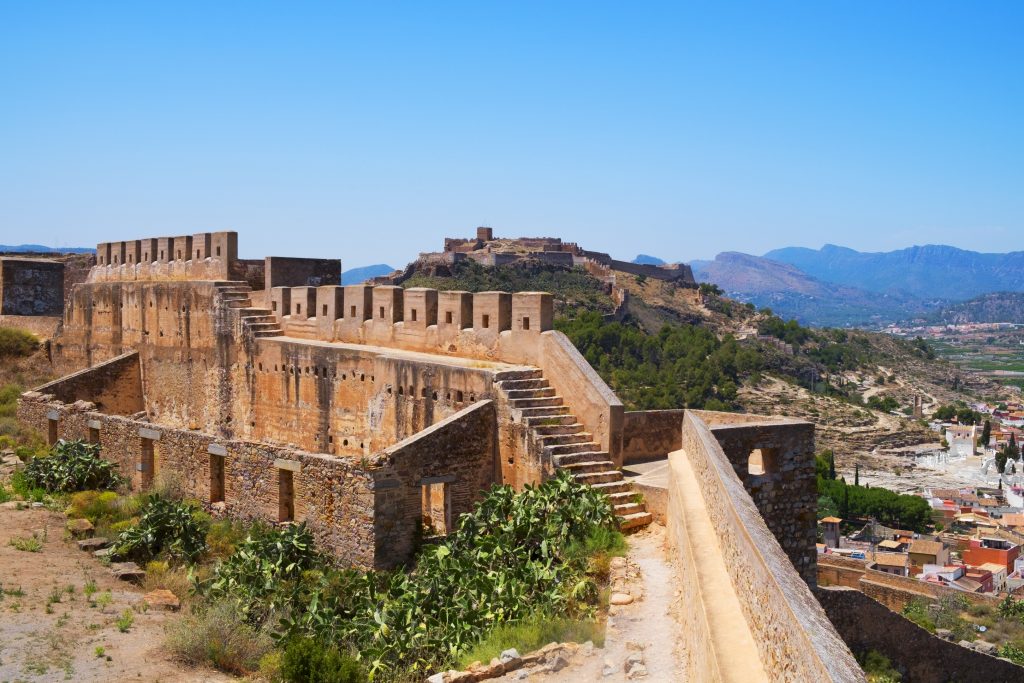 Roman ruins in Sagunto, Costa del Azahar. Photo by: ATLANTISMEDIA/Stock
Roman ruins in Sagunto, Costa del Azahar. Photo by: ATLANTISMEDIA/Stock
Costa del Azahar
This stretch of eastern coastline is known as the Orange Blossom Coast due to the groves of orange trees that grow here. It’s located in the Valencia region, and the province of Castellón, between Vinaròs and Dénia. Less of a tourist honeypot than others, this Costa is great for families as it has more of a laidback atmosphere. It incorporates Valencia, the third largest city in Spain. Be sure to try some traditional Valencian paella during your stay.
Discover the Roman ruins in the town of Sagunto, and Castellón de la Plana, the capital city of the province of Castellón. Visit the reconstructed Gothic-style Concatedral de Santa Maria. Stroll to the City Hall to see it’s pretty Tuscan-style façade. The area is famous for the music festival, Festival Internacional de Benicàssim (FIB). Spend some time in Peniscola, the fortified sea port established by the Knights Templar in the 14th century. The town sticks out into the sea, connected to Spain by a thin strip of land. It was used as a filming location for Game of Thrones, in which it became the fictional town of Meereen.
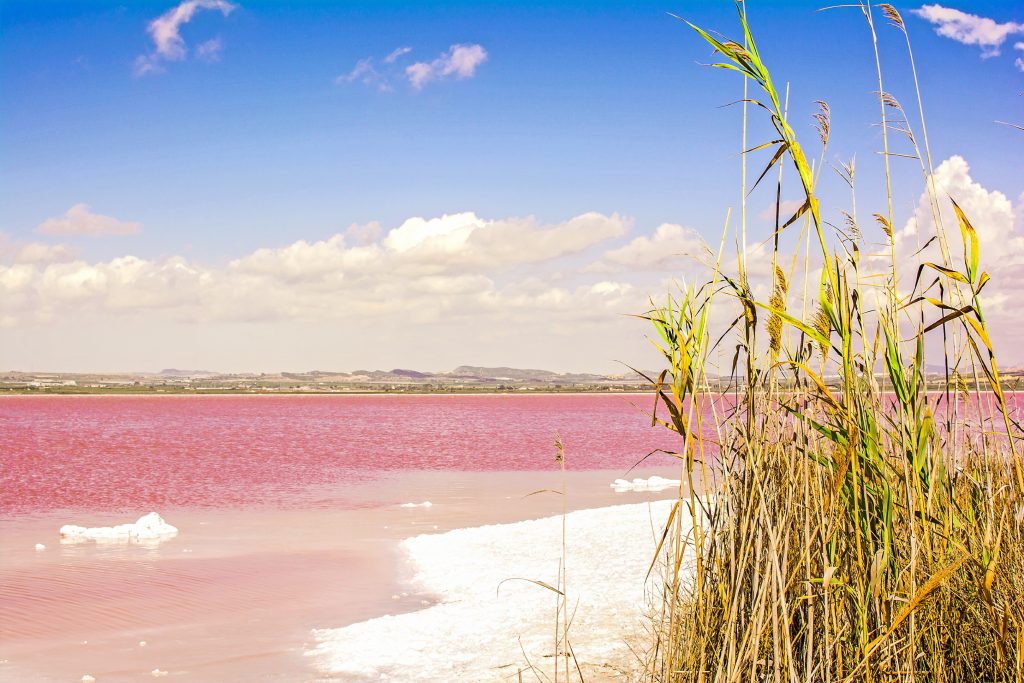 One of the salt lakes in Torrevieja, which takes on a pink colour. Costa Blanca. Photo by: elenag177/Stock
One of the salt lakes in Torrevieja, which takes on a pink colour. Costa Blanca. Photo by: elenag177/Stock
Costa Blanca
The 200km “White Coast” is located along the south-east in the province of Alicante. Starting at Dénia, the Costa Blanca runs down south to Pilar de la Horadada. The area is well-developed for tourism and you’ll find a wide variety of activities and accommodation here. The biggest centres here for tourist activity are the cities of Benidorm and Alicante. Should you be booked into a resort in Benidorm, you can collect your Benidorm car hire centrally, allowing for a short-term rental if you wish to discover areas further afield. Alternatively, pick up your hire car when you land at Alicante Airport.
The charming habitats of Calpe, Javea and Dénia await you. Dénia in particular has an attractive fishing harbour and both Roman and Moorish architecture. Visit the castle for breath-taking views over the city. Partake in snorkelling or scuba diving, or jump aboard the daily ferries to the Balearic Islands. Calpe boasts some architectural structures of historical significance, including the La Iglesia Antigua, or The Old Church, which can be entered through the Church of Mare de Déu de les Neus. It’s the only remaining Gothic-Mudéjar church in the Valencia region.
Torrevieja has two large salt lakes that can be visited, Les Salines. The name of the town derives from the Spanish term meaning “old tower”, and it was built around the main watchtower, Torre del Moro. It’s free to visit and offers some fantastic views of the Costa Blanca and the Mediterranean. There’s also the Museo Flotante, two floating museums aboard the Delfin (a French-built submarine) and the Albatross III, a Coast Guard patrol boat.
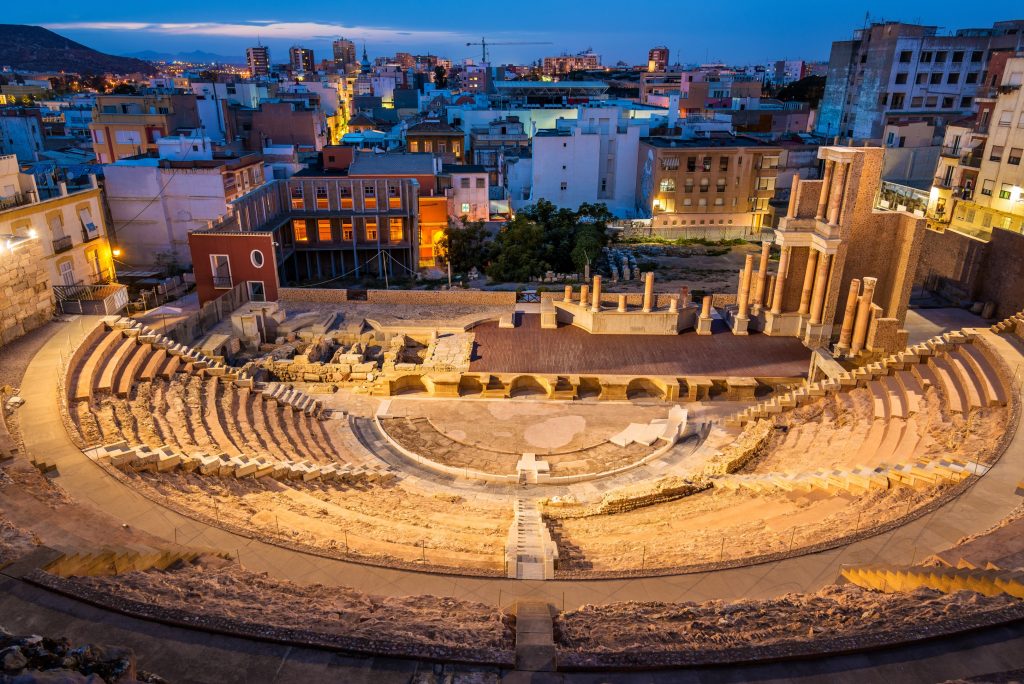 Roman ruins in Cartagena, Costa Cálida. Photo by: elenag177/Stock
Roman ruins in Cartagena, Costa Cálida. Photo by: elenag177/Stock
Costa Cálida
Located in the province of Murcia, this 250km length of coastline has its own microclimate which keeps it enjoyably warm. It’s the climate that lends to its name of the “Warm Coast”. Visit Mar Menor (“Lesser Sea”), an inland sea water lagoon near La Manga, the largest in Europe. Nearby are Cartagena, Los Alcázares, San Pedro del Pinatar and San Javier, where you can collect your hire car from at the Murcia-San Javier Airport. Cartagena has several Roman remains worth visiting, including the now-restored Carthago Nova, an outdoor theatre dating back to the 2nd century BC. Those with an interest in archaeology should visit the Municipal Archaeological museum and the Argua, a National Museum of Maritime Archaeology. The city boasts the highest number of beaches in Spain with the Q for Quality rating, with 10 in total.
Golfing is also an attraction to the area, with the Hacienda del Álamo being the longest golf course in Spain. There are also other PGA championship courses, including El Valle and the La Manga Club, which covers 1400 acres.
Other Spanish costas
Further around the south coast are the Costa Almería, Costa Tropical, Costa del Sol, and Costa de la Luz. The north coast contains the Costa de Morisco, Costa Verde, Costa Cantabria and the Costa Vasca. We’ll cover these in future blogs so keep your eyes peeled!
The east coast Costas your way
With car hire in Spain, you can collect your vehicle when you land at one of the many popular airports and jump straight into your holiday. Let us know in the comments below whether you’ve visited any of the Costas on the east coast of Spain, and what highlights you’d recommend to other travellers. If you’re due to visit, let us know what you’re most looking forward to seeing or doing. We love to hear from you.
Make sure you follow us on Twitter and Facebook for the latest travel tips and news. Remember to sign up to our newsletter below for the latest deals.
Subscribe to our newsletter
Want our blogs emailed direct to you? Sign up below to get updates featuring our blogs and car hire top tips. Receive the best deals on car hire straight to your inbox.



